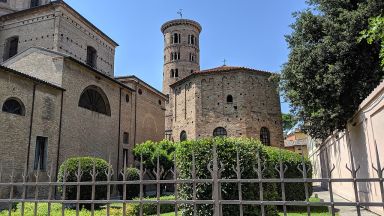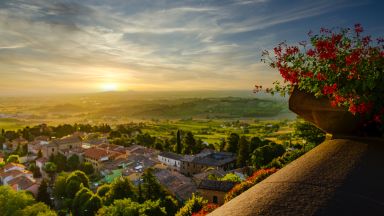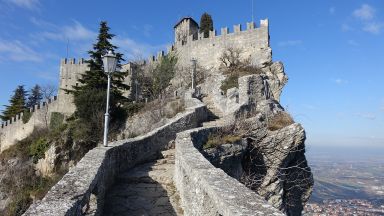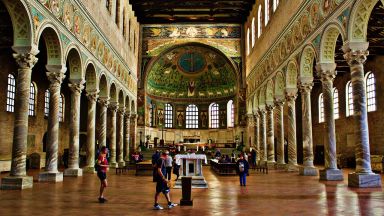Battistero Neoniano (o degli Ortodossi)
Baptistery in Ravenna

The Neonian Baptistery, also known as the Orthodox Baptistery, is one of the oldest early-Christian monuments in Ravenna and has been a UNESCO World Heritage site since 1996. Its stunning interior decorations, particularly its mosaics, have captivated visitors, including the renowned psychoanalyst Carl Gustav Jung, who described his visit as a mesmerizing “hallucination.”
A Bit of History:
- The baptistery likely dates back to the early 5th century AD and was constructed under the patronage of Bishop Ursus when Ravenna became the capital of the Western Roman Empire.
- Bishop Neon (450 – 475 AD) initiated a series of restoration works a few decades after its construction. These included refurbishing the cupola and enhancing the interior decorations, which are still preserved today.
- Unlike many other baptisteries from the 4th and 5th centuries, which have not survived as well, the Neonian Baptistery remains remarkably intact both architecturally and ornamentally.
Architectural Features:
- The baptistery has an octagonal plan with bare brick walls that alternate between straight and apsidal sections. It features round arch windows at the top and underground doors.
- Inside, there are two tiers of arcades along the walls. The decoration within the baptistery is divided into three levels: marbles in the lower part, stucco in the middle, and mosaics in the upper part.
The Dome’s Decoration:
- The dome’s iconography is organized in an ascending direction, from the outermost part to the center, with its climax in the clypeus.
- The outermost strip of the dome is divided into eight sections, alternating between natural motifs, empty thrones representing the Day of Universal Judgment, and altars with Gospels.
- In the middle strip, set against a blue background, the twelve apostles are depicted in tunics and cloaks, divided into two groups led by St. Paul and St. Peter. They walk in a circle, carrying laurel wreaths, a symbol of triumph, in their hands.
- At the centre of the dome is a large medallion portraying Christ standing in the crystal-clear waters of the Jordan River alongside John the Baptist. This mosaic is the oldest known depiction of Christ’s baptism inside a monument.
- In the centre of the baptistery stands an octagonal basin made of Greek marble and porphyry, which was rebuilt in the 6th century but still preserves some original fragments from the 5th century.
The Battistero Neoniano (o degli Ortodossi) appears in our Complete Guide to Visiting Ravenna!
This website uses affiliate links which may earn a commission at no additional cost to you!
Visiting Battistero Neoniano (o degli Ortodossi)
Until 3rd March
Every day: 10 am – 5 pm
From 4th March to 1st November
Every day: 9 am – 7 pm
€10.50 – The combined ticket includes the entry to Basilica of Sant’Apollinare Nuovo, Neonian Baptistery (**), Basilica of San Vitale, Mausoleum of Galla Placidia (**) and Archiepiscopal Museum and Chapel.
Nearby Attractions
- Archbishop's Museum, Ravenna (0.1) km
Museum in Ravenna - Archbishop's Chapel of St. Andrew (0.1) km
Church in Ravenna - Basilica of San Francesco, Ravenna (0.3) km
Basilica in Ravenna - Dante Alighieri’s Tomb (0.3) km
Tomb in Ravenna - Museo Dante, Ravenna (0.3) km
Historic Building and Museum in Ravenna - Piazza del Popolo, Ravenna (0.3) km
Square in Ravenna - Domus dei Tappeti di Pietra (House of the Stone Carpets) (0.4) km
Historic Site and Museum in Ravenna - National Museum of Ravenna (0.5) km
Historic Building and Museum in Ravenna - Arian Baptistery (Battistero degli Ariani) (0.5) km
Baptistery in Ravenna - Basilica of San Vitale (0.6) km
Basilica in Ravenna


